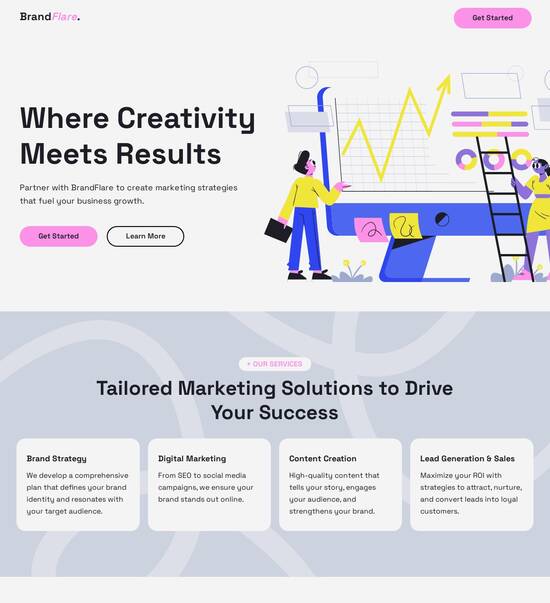
Design Google Chrome-ready 404 error page templates
Explore Similar TemplatesAbout template
Choose the best 404 error page template for Google Chrome
Recommended templates

Easy to build without coding
With the intuitive drag-and-drop builder, anyone on your team can create high-converting pages without any knowledge of code or design. Make enhancements to your landing page with custom widgets using Javascript, HTML/CSS, or third-party scripts.

Multiple layouts for any industry and goal
Select from 500+ landing page layouts built to boost conversions across industry-specific scenarios. Customize them by adjusting fonts, adding images, and generating on-brand content with the AI assistant. Quickly scale with Instablocks® and Global Blocks that you can save, reuse, and update globally.

Loads fast and looks polished on any device
Every template is responsive, which means they present professionally on any device and load blazingly fast with our Thor Render Engine. You can also power them up with Google AMP technology to deliver an unparalleled mobile experience and drive higher conversions.

Robust analytics & experimentation
Get real-time updates and reporting across all your devices, showing the number of visitors, conversions, cost-per-visitor, and cost-per-lead. Launch AI-powered experiments, run A/B tests, and use heatmaps to analyze user behavior, then optimize your landing page to maximize conversions.







Easy to build without coding
With the intuitive drag-and-drop builder, anyone on your team can create high-converting pages without any knowledge of code or design. Make enhancements to your landing page with custom widgets using Javascript, HTML/CSS, or third-party scripts.
Multiple layouts for any industry and goal
Select from 500+ landing page layouts built to boost conversions across industry-specific scenarios. Customize them by adjusting fonts, adding images, and generating on-brand content with the AI assistant. Quickly scale with Instablocks® and Global Blocks that you can save, reuse, and update globally.
Loads fast and looks polished on any device
Every template is responsive, which means they present professionally on any device and load blazingly fast with our Thor Render Engine.
Robust analytics & experimentation
Get real-time updates and reporting across all your devices, showing the number of visitors, conversions, cost-per-visitor, and cost-per-lead. Launch AI-powered experiments, run A/B tests, and use heatmaps to analyze user behavior, then optimize your landing page to maximize conversions.
All the features you need to build lead-generating landing pages
Explore more featuresLearn how to build top-performing landing pages for any goal
FAQs
Leading the way in building high-performing landing pages





A comprehensive guide to creating landing pages with Instapage
In the fast-paced arena of digital marketing, having the right tools can significantly affect your campaign's success. Instapage stands out as a powerful landing page and conversion rate optimization (CRO) platform, designed to equip marketers with all the essentials needed to enhance their digital marketing efforts. This guide walks you through the step-by-step process of utilizing Instapage for your landing pages, ensuring you maximize your ROI effectively.
Understanding Instapage
Instapage simplifies the landing page creation process with its user-friendly interface and extensive template library. With over 100 conversion-focused templates, users can easily customize their landing pages without needing any coding skills. This accessibility makes it particularly appealing for marketers of all experience levels.
- Pre-built templates: Choose from a variety of high-converting designs tailored to different industries, allowing for quick adaptations to your marketing strategies.
- Drag-and-drop builder: Instapage's intuitive platform lets you effortlessly place elements on the page for a personalized look.
- Lead capture elements: Integrate forms and call-to-action buttons designed to capture visitor data and convert them into leads.
Optimizing landing pages for conversions
To ensure your landing page is effective, optimization is key. Instapage offers built-in experimentation features that help test different versions of your pages to see which performs best.
- A/B testing: Compare two landing page versions to determine which one yields better results in terms of lead generation and engagement.
- Heatmaps: Utilize detailed analytics to visualize user interactions on your page, enabling you to identify where visitors click the most.
- Analytics dashboard: Monitor your page metrics, including conversion rates and visitor engagement, to make informed decisions for further improvements.
Personalizing your content
Tailoring your content to fit the unique needs of various audience segments can greatly enhance conversion rates. Instapage facilitates this through dynamic text replacement and audience segmentation.
- Dynamic text replacement: Automatically change headlines and content based on the visitor’s source, making each user experience unique.
- AdMaps integration: Align specific ads with dedicated landing pages, ensuring consistency in messaging and increasing relevancy for users.
- Audience-level tracking: Gain insights into different audience behaviors, enabling more focused marketing strategies.
By implementing these strategies, your landing pages can capitalize on targeted marketing efforts, reaching and converting your desired audience more effectively.
Start improving your digital marketing campaigns today using Instapage. The platform offers the tools to create, optimize, and personalize your landing pages for maximum effectiveness.
Ready to accelerate your campaign success? Sign up for Instapage and harness the power of effective landing pages and CRO strategies today!
People also ask about 404 error page template optimized for Google Chrome
404 error page template optimized for Google Chrome
Understanding the 404 error page: A necessity in web navigation
A 404 error page is an essential component of web navigation that informs users when they attempt to access a page that does not exist on a website. This can occur for various reasons, including deleted pages, broken links, or misconfigured URLs. The significance of having a well-designed 404 error page cannot be overstated, as it serves both as a guide and a point of engagement for users who reach this dead end.
Enhanced user experience when users encounter an error.
Provides an opportunity to guide users back to relevant content.
Potential to reduce bounce rates and retain visitors.
The role of 404 error pages in user experience
404 error pages play a crucial role in maintaining user experience on a website. Statistics show that poorly designed 404 pages can lead to a significant drop in user retention, with users often leaving the site immediately after encountering a dead link. Conversely, a well-crafted error page can keep users engaged by directing them to other areas of the site, providing useful resources, and creating a more positive interaction even in the face of an error.
Common scenarios that may lead to 404 errors include misspellings in the URL, moving or deleting content without proper redirection, and external links that point to outdated pages. These errors can frustrate users and diminish trust in the website, making it vital for businesses to address these occurrences with effective error pages.
Technological foundations of an optimized 404 error page
Understanding how web servers generate and handle 404 errors is key to developing an effective error page. When a server cannot find the requested page, it responds with a 404 HTTP response code. This code alerts browsers and search engines that the requested resource is unavailable. Using these HTTP response codes effectively allows for better management of user expectations and aids in the retrieval of necessary resources.
The technologies behind designing an optimized 404 page include HTML for structure, CSS for styling, and JavaScript for interactivity. Each of these elements can enhance the user experience by creating visually appealing and functional error pages that serve a purpose beyond merely displaying an error message.
Design principles for an engaging 404 error page
Employing user-centric design techniques is fundamental while creating an error page. Effective color schemes should harmonize with the overall website design, ensuring brand consistency while remaining appropriately subdued to indicate an error. Typography is equally important, as clear and legible text allows users to navigate easily despite the disruption.
Visual elements like images, icons, and animations can enhance the overall impact of the 404 page. Engaging graphics may divert user frustration and turn the experience into a light-hearted moment. Furthermore, ensuring that the design is responsive is crucial, as users access websites through various devices today. An adaptive layout helps maintain usability across different screen sizes, keeping engagement high.
Essential features of a Chrome-optimized 404 error page template
A Chrome-optimized 404 error page template must incorporate essential features that enhance user experience. Speed optimization is paramount; slow-loading pages can increase frustration and lead to user abandonment. Minimizing load times and utilizing efficient coding practices can significantly improve performance.
User-friendly navigation options, including links back to popular pages.
Search bar integration enables quick access to desired content.
Dynamic content options, such as displaying recent posts or products, keeps users engaged.
Tailoring the content for community engagement
Crafting messages that align with the brand's voice is vital for engaging users during an error experience. A personal touch in the dialogue can foster a connection, even when things go wrong. Encouraging user interaction through feedback forms, Q&A sections, or community forums keeps lines of communication open and helps users feel valued.
Creating channels for users to connect with support resources can encourage a more communal atmosphere, where knowledge sharing occurs organically. By promoting community knowledge and reinforcing user support channels, businesses can turn a potentially negative experience into a constructive one, enhancing brand loyalty.
Harnessing visual content for enhanced understanding
Visual content has a powerful impact on user understanding, especially in the context of error pages. Engaging graphics and illustrations should not only catch the eye but also complement the message being conveyed. Infographics can present common causes of 404 errors, helping users identify issues quickly and providing valuable context.
Integrating videos or gifs that guide users with resolution steps can further enhance their experience. This multimedia approach can transform frustration into informed engagement, as users receive not only help but also insights into resolving similar issues in the future.
Collecting user insights through analytics
Utilizing tools such as Google Analytics is vital for tracking the performance of your 404 error page. By setting up event tracking, you can monitor how users interact with the error page, providing insights into behavior and engagement. Heatmaps can also reveal where users click, allowing for further adjustments to enhance user experience.
Interpreting this data is crucial to refining the error page experience. By identifying trends and patterns, businesses can make informed decisions on design tweaks or content adaptations that resonate with user needs, turning a negative moment into a valuable opportunity for improvement.
Location-based customizations for increased relevance
Implementing geolocation features on 404 error pages allows for the delivery of region-specific content, enhancing user relevance. For example, users from different regions may respond positively to localized error messages that reflect their culture or language, thereby fostering a stronger connection between users and the brand.
Localized error messages can improve user experience significantly.
Special promotions or relevant information relevant to a user’s geographic location can drive engagement.
Strategies to leverage location data can enhance user interaction and retention.
Community feedback: Building a collective approach
Establishing channels for users to report issues or share experiences enhances the collective approach to managing 404 error pages. Creating feedback forms enables users to voice their thoughts directly, helping businesses understand the user experience on a granular level.
Community-driven content can also play a significant role in building a dedicated user base. Showcasing user-generated solutions and experiences fosters trust and encourages collaboration. This sense of community support can transform a negative experience into a positive engagement opportunity.
Futureizing 404 pages: Incorporating AI and machine learning
AI innovations hold tremendous potential for improving 404 error pages by anticipating user needs. Leveraging machine learning algorithms can help refine the error page experience by analyzing user interactions and tailoring the content dynamically to increase satisfaction and reduce frustrations.
Predictive analysis tools can minimize the occurrence of 404 errors by identifying patterns that typically lead to broken links. By addressing these issues proactively, businesses can significantly enhance user experience and reduce the frequency of users encountering 404 errors.
Enhancing team collaboration in error page creativity
Cross-functional teamwork is essential in the development of error page templates. Collaboration between web developers, designers, and marketing teams can yield creative and effective solutions that prioritize user experience. Utilizing collaboration tools allows team members to share ideas, offer feedback, and iterate designs rapidly.
Tools like Slack or Trello facilitate real-time communication.
Allowing for shared repositories of designs and analytics data promotes transparency and innovation.
Regular brainstorming sessions ensure a steady flow of creative ideas and best practices.
Answering common questions about 404 error pages
Many questions arise regarding the structure and effectiveness of 404 error pages. For instance, a well-designed 404 error page should include clear messaging that acknowledges the error, offers navigation options back to the relevant content, and possibly highlights popular pages or recent articles.
Moreover, businesses often wonder how a 404 page can affect SEO. Google views 404 errors as important indicators regarding a website's navigation and user experience. It's essential to ensure that these errors are managed effectively to avoid potential penalties that could affect overall search rankings.
Previews and testing: Ensuring functionality before launch
User testing of 404 error pages is a critical step in ensuring functionality and user satisfaction. Techniques to test include A/B testing different designs with varying messages to determine the best approach that resonates with users. Collecting data from these tests can guide adjustments and enhancements to the final product.
Pre-launch testing also allows for identifying any potential bugs or issues that may impact performance once the page goes live. Ensuring smooth functionality at this stage can prevent miscommunication and improve users' experiences when they reach a 404 error.
The impact of a well-designed 404 error page on online presence
Investing in optimizing 404 error pages has shown significant long-term benefits for brands. Case studies reveal successful websites that transformed their 404 pages into engaging experiences, from humorous visuals to interactive elements that lead users back to the broader site. This approach not only improves user satisfaction but can also enhance brand loyalty.
By creating a positive error page experience, businesses can foster trust among customers, leading to increased retention and repeat visits. In turn, enhancing the overall online presence becomes a natural outcome of viewing 404 error pages not just as errors, but as opportunities for engagement and creativity.
Ready to skyrocket conversions?
Supercharge your ad campaigns with high-performing landing pages
Get started














